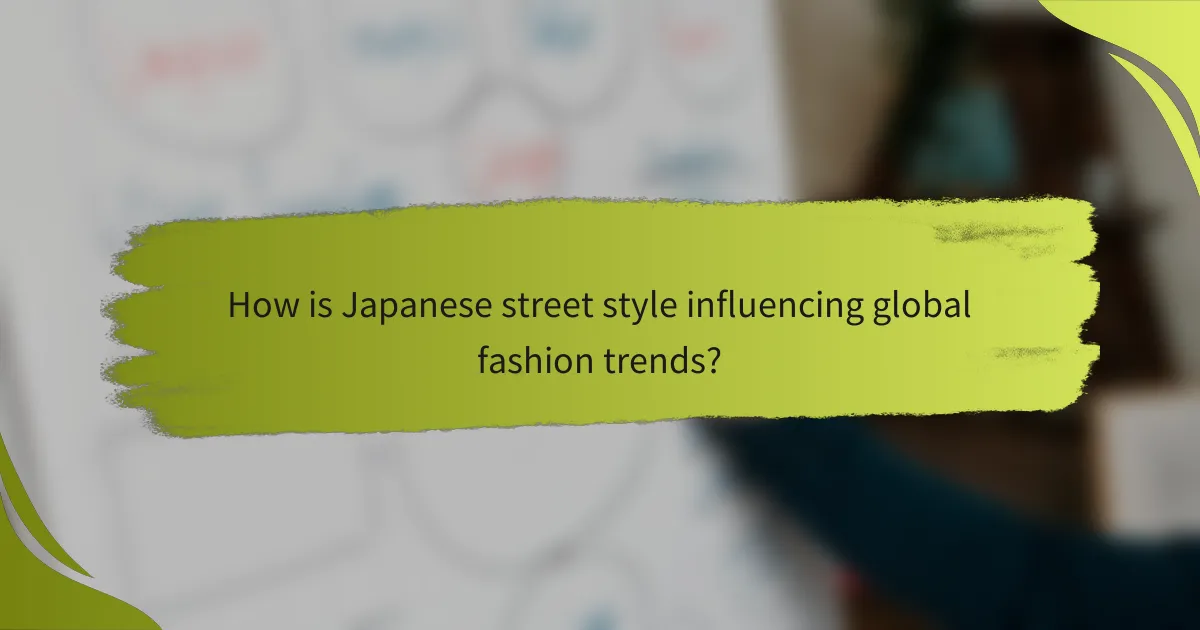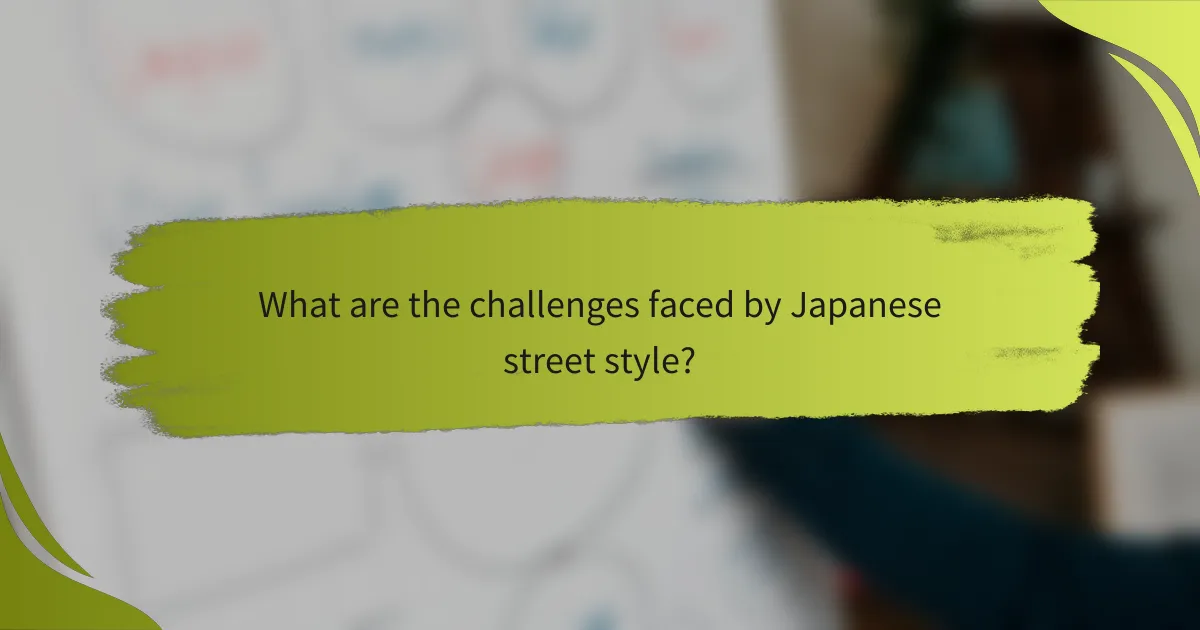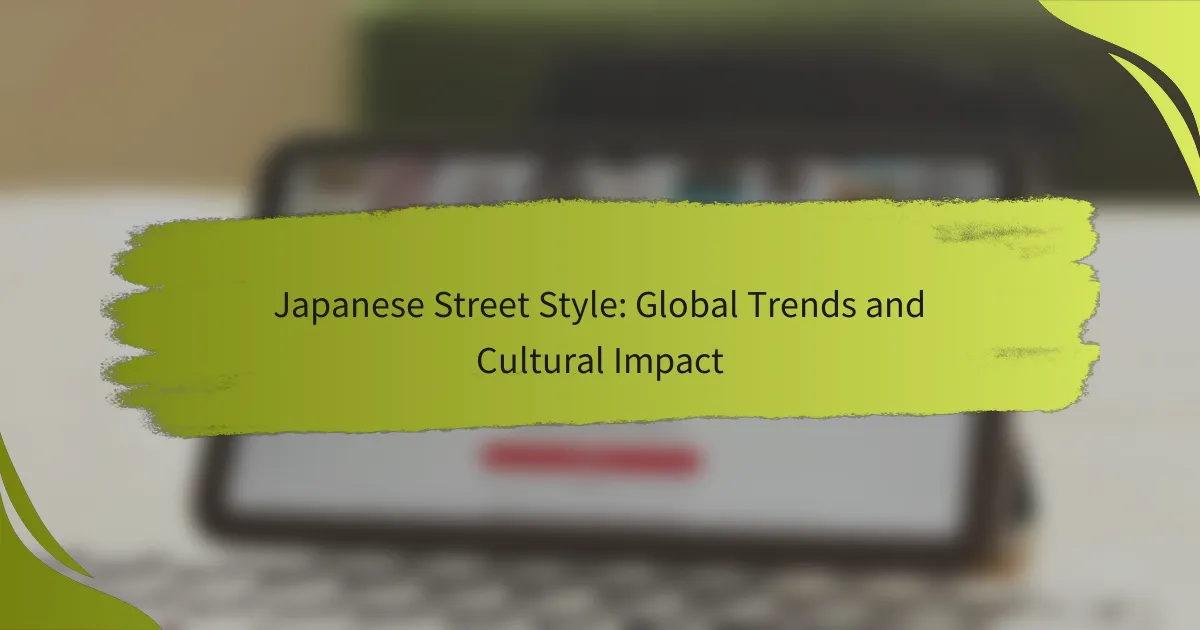Japanese street style plays a pivotal role in shaping global fashion trends, showcasing a distinctive blend of cultural influences and innovative aesthetics. Characterized by its eclectic mix of layering, bold colors, and diverse subcultures, this fashion phenomenon reflects both traditional elements and contemporary expressions, creating a vibrant scene that resonates with youth culture worldwide.

How is Japanese street style influencing global fashion trends?
Japanese street style significantly shapes global fashion trends by introducing unique aesthetics and cultural elements. This influence is evident in various fashion capitals, where designers and brands incorporate Japanese motifs and styles into their collections.
Global adoption of Harajuku aesthetics
The Harajuku district in Tokyo is renowned for its vibrant street fashion, characterized by bold colors, eclectic layering, and playful accessories. This aesthetic has gained traction worldwide, inspiring fashion enthusiasts and designers alike to experiment with unconventional styles. Cities like New York and London now feature Harajuku-inspired looks in their street style scenes, showcasing a blend of cultures.
Fashion events and social media platforms have further accelerated the global adoption of Harajuku aesthetics, enabling diverse interpretations of this style. Many brands now offer collections that reflect these influences, appealing to a broader audience seeking individuality in their clothing choices.
Impact on luxury brands like Gucci
Luxury brands, including Gucci, have embraced elements of Japanese street style to attract younger consumers. This shift is evident in their collections, which often feature bold prints, oversized silhouettes, and a mix of traditional and contemporary designs. By incorporating these styles, luxury brands create a sense of accessibility while maintaining their high-end appeal.
Collaborations with Japanese artists and designers have further enhanced this trend, allowing brands to tap into the rich cultural heritage of Japan. Such partnerships not only elevate the brand’s image but also resonate with consumers who appreciate the fusion of luxury and street style.
Collaboration with Western designers
Collaborations between Japanese and Western designers have become increasingly common, blending distinct cultural influences to create innovative fashion. These partnerships often result in unique collections that reflect the strengths of both design philosophies, appealing to a global audience. For example, collaborations may combine Japanese minimalism with Western boldness, resulting in fresh, eye-catching pieces.
Fashion weeks and trade shows frequently showcase these collaborations, highlighting the importance of cross-cultural exchange in the industry. As designers continue to explore these partnerships, the influence of Japanese street style on global fashion will likely expand, fostering creativity and diversity in design.

What are the key elements of Japanese street style?
Japanese street style is characterized by its eclectic mix of fashion influences, creativity, and individuality. Key elements include layering, bold colors, and the impact of various subcultures that shape trends and personal expression.
Layering techniques
Layering is a fundamental aspect of Japanese street style, allowing individuals to create unique looks by combining various garments. This technique often involves mixing different textures and lengths, such as pairing oversized jackets with fitted tops or long skirts with cropped sweaters.
When layering, consider the balance of proportions and colors. For instance, a long tunic can be paired with a shorter jacket to create visual interest. Experimenting with different fabrics, like denim, cotton, and silk, can also enhance the overall aesthetic.
Use of bold colors and patterns
Bold colors and striking patterns are essential in Japanese street style, often reflecting the wearer’s personality and mood. Bright hues, graphic prints, and playful motifs can be seen in various outfits, making them stand out in urban environments.
To effectively incorporate bold colors and patterns, start with one statement piece, such as a patterned shirt or vibrant pants, and build the outfit around it. Pairing these items with neutral tones can help balance the overall look while still showcasing the vibrant elements.
Influence of subcultures like Gyaru
Subcultures such as Gyaru have significantly influenced Japanese street style, promoting distinctive fashion choices that emphasize individuality. Gyaru fashion is known for its glamorous and often exaggerated aesthetic, featuring elements like dramatic hairstyles, heavy makeup, and eye-catching accessories.
Understanding the impact of these subcultures can inspire personal style. For example, incorporating Gyaru-inspired accessories, such as platform shoes or bold jewelry, can add a unique touch to everyday outfits. Embrace the spirit of these subcultures by mixing and matching elements that resonate with your personal style.

How do cultural factors shape Japanese street style?
Cultural factors significantly influence Japanese street style, blending traditional elements with contemporary trends. This unique fusion creates a vibrant fashion scene that reflects Japan’s rich heritage and the dynamic nature of its youth culture.
Historical influences from traditional clothing
Japanese street style often draws inspiration from traditional garments such as kimono and yukata. These pieces are reimagined in modern contexts, incorporating bold colors and patterns that resonate with today’s fashion sensibilities.
For instance, the layering techniques seen in traditional attire are echoed in contemporary outfits, allowing for personal expression while honoring cultural roots. Designers frequently integrate motifs and fabrics reminiscent of historical clothing, creating a dialogue between past and present.
Role of youth culture in fashion evolution
Youth culture plays a pivotal role in the evolution of Japanese street style, with young people often at the forefront of fashion innovation. This demographic embraces experimentation, mixing various styles to create unique looks that challenge conventional norms.
Subcultures such as Harajuku and Gyaru exemplify this trend, where individuality and creativity are celebrated. The influence of social media has further amplified these styles, allowing trends to spread rapidly and encouraging a global exchange of ideas.
Impact of anime and pop culture
Anime and pop culture significantly shape Japanese street style, inspiring fashion choices that reflect characters and themes from popular media. Many fans incorporate elements from their favorite series into their daily outfits, creating a playful and imaginative aesthetic.
Cosplay, the practice of dressing as characters from anime or video games, has also influenced mainstream fashion. This trend encourages bold colors, elaborate accessories, and a sense of fun, making it a staple in the wardrobes of many young Japanese individuals.

What are the popular brands in Japanese street style?
Japanese street style is characterized by a mix of unique aesthetics and cultural influences, with several brands leading the charge. Notable names include Uniqlo, Comme des Garçons, and Neighborhood, each offering distinct approaches that reflect the diversity of urban fashion in Japan.
Uniqlo’s minimalist approach
Uniqlo is renowned for its minimalist designs that emphasize functionality and simplicity. The brand focuses on high-quality basics that appeal to a broad audience, making it a staple in many wardrobes. Items like their Ultra Light Down jackets and AIRism clothing line exemplify their commitment to comfort and practicality.
When shopping at Uniqlo, consider layering pieces to create versatile outfits. Their color palette often includes neutral tones, which can easily be mixed and matched. This approach allows for effortless styling while maintaining a clean aesthetic.
Comme des Garçons’ avant-garde designs
Comme des Garçons is celebrated for its avant-garde and often unconventional designs that challenge traditional fashion norms. Founded by designer Rei Kawakubo, the brand is known for its deconstructed silhouettes and innovative use of materials. Collections often feature asymmetrical cuts and bold patterns, appealing to those who seek to make a fashion statement.
For those interested in exploring Comme des Garçons, consider investing in signature pieces like their iconic heart logo t-shirts or unique outerwear. These items not only showcase the brand’s artistic vision but also serve as conversation starters in any street style ensemble.
Neighborhood’s streetwear offerings
Neighborhood is a prominent name in Japanese streetwear, blending influences from motorcycle culture and American workwear. The brand is known for its rugged aesthetics, featuring graphic tees, denim, and outerwear that often incorporate bold prints and logos. This combination creates a distinctive look that resonates with street style enthusiasts.
When selecting pieces from Neighborhood, focus on layering and accessorizing to enhance your street style. Items like their signature jackets or graphic hoodies can be paired with distressed jeans or cargo pants for a cohesive look. Keep an eye on limited edition drops, as these often become sought-after collector’s items.

How do social media platforms affect Japanese street style?
Social media platforms significantly influence Japanese street style by shaping trends and facilitating the rapid exchange of fashion ideas. They allow users to showcase their unique styles and connect with global fashion movements, creating a dynamic environment where local and international influences merge.
Instagram as a visual showcase
Instagram serves as a primary platform for showcasing Japanese street style, allowing users to share visually striking outfits with a global audience. The platform’s emphasis on high-quality images encourages creativity and originality, leading to the emergence of distinct fashion subcultures within Japan.
Users often curate their feeds to reflect specific aesthetics, which can inspire followers to adopt similar styles. Hashtags related to Japanese fashion, such as #Harajuku or #Gyaru, help categorize content and make it easily discoverable, further amplifying trends.
Influencer collaborations driving trends
Influencers play a crucial role in shaping Japanese street style by collaborating with brands and designers. These partnerships often result in limited-edition collections that attract significant attention and drive consumer interest. Influencers leverage their large followings to promote these collaborations, making them a powerful marketing tool.
Brands often seek out influencers whose styles resonate with their target audience, ensuring that the collaboration feels authentic and appealing. This strategy not only boosts sales but also helps to establish new trends within the fashion community.
Emergence of TikTok fashion challenges
TikTok has introduced a new dimension to Japanese street style through viral fashion challenges that encourage users to showcase their outfits in creative ways. These challenges often involve specific themes or styles, prompting participants to interpret them uniquely, which can lead to unexpected fashion trends.
The platform’s algorithm promotes engaging content, allowing popular challenges to spread rapidly among users. As a result, TikTok has become a significant player in the fashion landscape, influencing how young people in Japan express their style and adopt new trends.

What are the challenges faced by Japanese street style?
Japanese street style faces several challenges, including commercialization and the preservation of cultural authenticity. As global trends influence local fashion, unique styles risk being diluted or lost in the process.
Commercialization of unique styles
The commercialization of Japanese street style often leads to the mass production of once-unique fashion items, which can undermine their original cultural significance. When brands capitalize on these styles, they may prioritize profit over authenticity, resulting in a loss of the creative spirit that defines street fashion.
For instance, popular streetwear brands may replicate niche styles, making them widely available but stripping away the individuality that made them special. This can create a homogenized fashion landscape where originality is sacrificed for commercial appeal.
To navigate this challenge, consumers can support local designers and boutiques that prioritize craftsmanship and cultural heritage. Engaging with fashion communities that value uniqueness can also help preserve the essence of Japanese street style.
